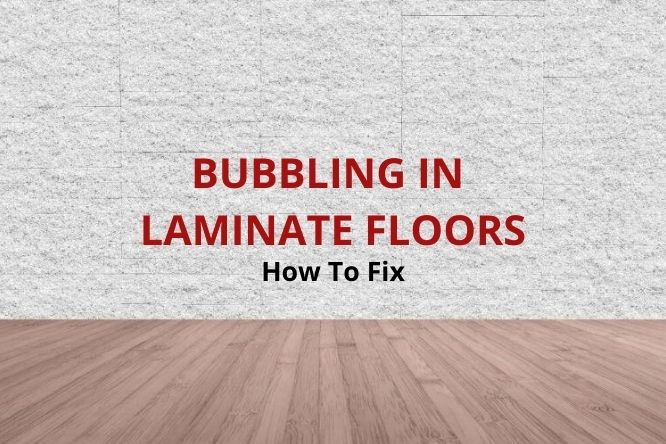Introduction
Laminate flooring, known for its durability and affordability, can sometimes develop unsightly bubbles that affect its aesthetic appeal and structural integrity. These bubbles may arise due to various factors, including moisture, inadequate installation, or excessive pressure. Understanding the causes and implementing effective repair techniques is crucial for restoring the beauty and longevity of your laminate flooring.

Image: flooring-experts.com
Causes of Bubbling in Laminate Flooring
Moisture Damage: Laminate flooring is susceptible to moisture damage, which causes the planks to expand and bubble. Water can penetrate through the joints of the flooring or from below, leading to moisture buildup and subsequent bubbling.
Improper Installation: Incorrect installation methods can result in uneven distribution of weight and pressure on the laminate planks. This can cause the edges of the planks to lift and create bubbles. Insufficient spacing along the walls and obstacles during installation can also contribute to bubbling.
Excessive Pressure: Heavy furniture or constant pressure on specific areas of the laminate flooring can lead to compression and permanent damage. Over time, the planks can buckle and form bubbles under the compressed points.
Step-by-Step Repair Guide
1. Identify the Source of the Problem: Determine the root cause of the bubbling by examining the condition of the flooring, surrounding areas, and potential moisture sources. Check for any water damage, gaps in the expansion gaps, or heavy furniture responsible for pressure buildup.
2. Remove Excess Moisture: If moisture is present, it must be removed to prevent further damage. Use a dehumidifier or fans to reduce excess moisture from the air. Allow the flooring to dry thoroughly. If the moisture originates from a subfloor or underlying layer, professional intervention may be necessary.
3. Remove the Bubbling Planks: Using a thin pry bar or putty knife, carefully lift and remove the damaged laminate planks. Ensure that you remove all the affected planks, regardless of their size or condition.
4. Inspect the Underlayment: Examine the underlayment for any damage or moisture. Remove and replace any damaged or wet underlayment to ensure a solid base for the new planks.
5. Clean the Subfloor: Clean the exposed subfloor thoroughly to remove debris and moisture. Allow the subfloor to dry completely before proceeding with the repair.
6. Install New Planks: Replace the removed planks with new ones that match the existing flooring. Ensure that the new planks are installed properly, leaving appropriate expansion gaps along the walls and other obstacles. Use a tapping block and hammer to lock the planks into place.
7. Weight Down the Floor: Once the new planks are installed, place heavy weights, such as sandbags or weights, on the repaired areas. This will help compress the planks and remove any remaining air or bubbles. Leave the weights in place for 24 to 48 hours to ensure proper bonding.
8. Reattach the Baseboards: After weighting down the floor, reattach the baseboards to cover the expansion gap and create a seamless transition between the flooring and walls. Use finishing nails or screws to secure the baseboards firmly.
Preventive Measures to Avoid Bubbling
1. Proper Installation: Ensure that your laminate flooring is professionally installed, leaving adequate expansion gaps along the walls and obstacles. Proper subfloor preparation is also critical for long-lasting performance.
2. Avoid Excess Moisture: Protect your laminate flooring from moisture by promptly mopping up spills and keeping humidity levels in check. Use a dehumidifier during humid seasons or in moisture-prone areas.
3. Use Furniture Protectors: To prevent permanent damage from heavy furniture, place furniture protectors or caster cups beneath the legs. Distribute the weight evenly to avoid pressure buildup.
4. Maintain a Consistent Temperature: Extreme temperature fluctuations can cause laminate flooring to expand or contract, potentially leading to bubbling. Maintain a consistent room temperature and avoid sudden heating or cooling.
5. Avoid Direct Sunlight: Prolonged exposure to direct sunlight can fade laminate flooring and cause deterioration. Use curtains or blinds to protect the flooring from excessive UV rays.

Image: floortechie.com
How To Fix Bubbling Laminate Floor
Conclusion
Fixing bubbling laminate flooring requires a thorough understanding of the causes and effective repair techniques. By addressing moisture issues, replacing damaged planks, and implementing preventive measures, you can restore your laminate flooring to its original beauty and protect it from future damage. Remember to conduct due diligence, seek professional assistance when necessary, and follow the steps outlined in this comprehensive guide to ensure a successful repair and prolong the lifespan of your laminate flooring.